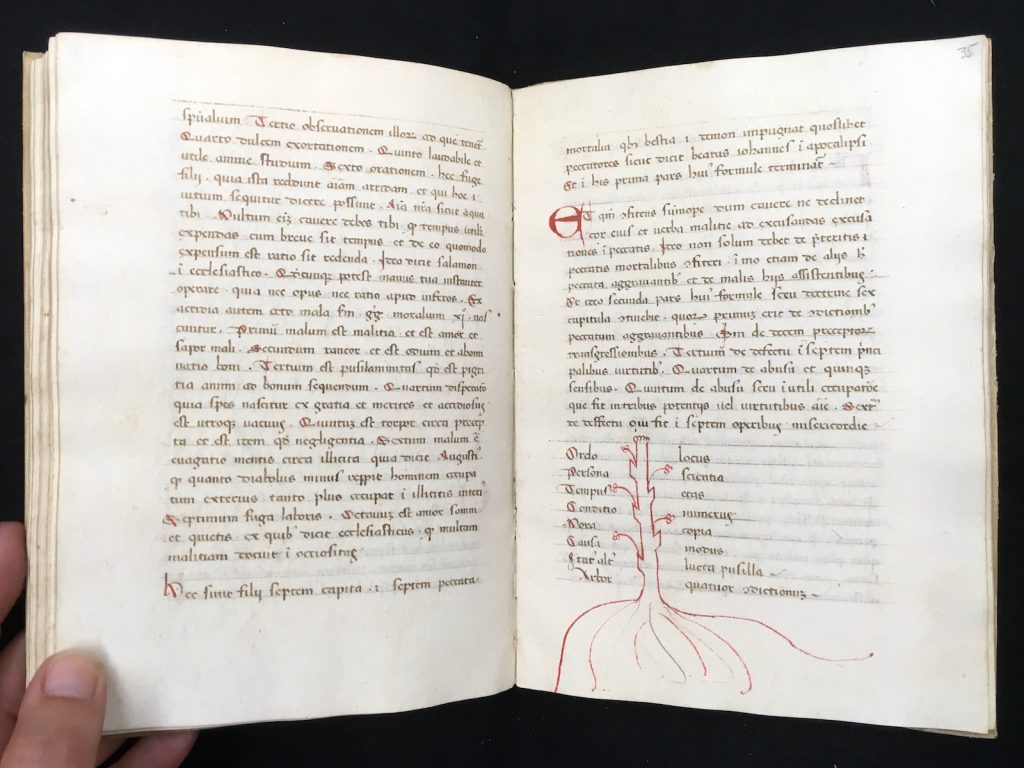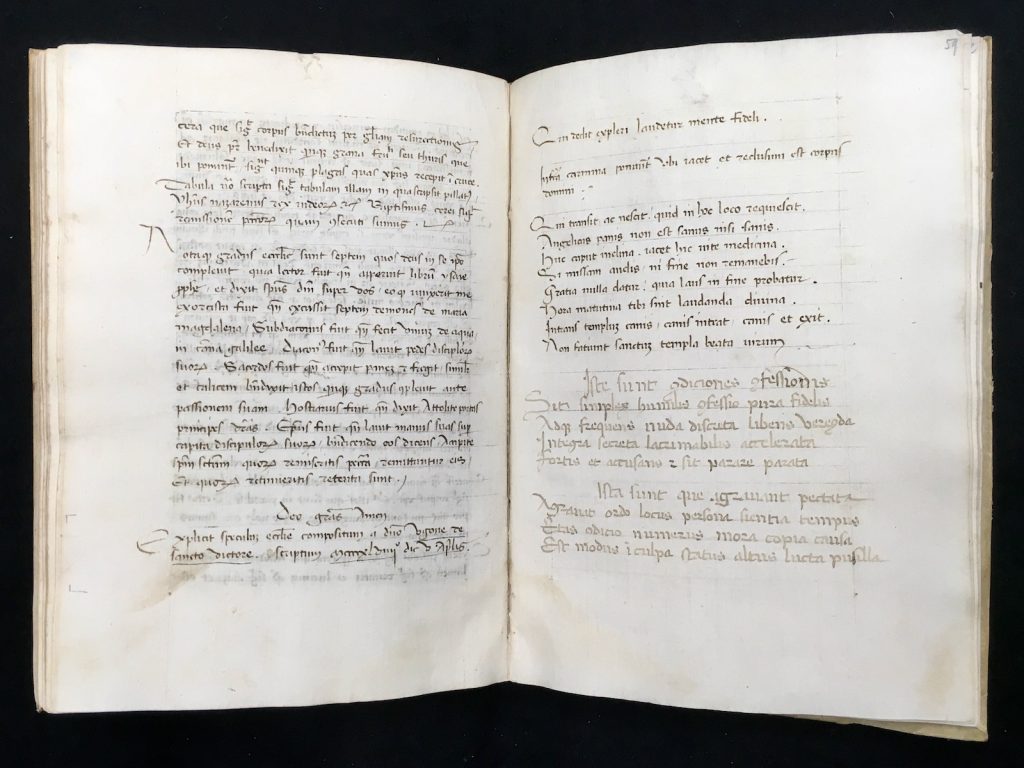Manuscript of the Month: The Art of Excerpting and the Encyclopedic Mind of the Middle Ages
January 27th, 2021N. Kıvılcım Yavuz is conducting research on pre-1600 manuscripts at the Kenneth Spencer Research Library. Each month she will be writing about a manuscript she has worked with and the current KU Library catalog records will be updated in accordance with her findings.
Kenneth Spencer Research Library MS C65 is a mid-fifteenth-century collection of theological writings focusing on topics such as vices, virtues, sin and penance. There are three short texts in the manuscript, all of which are largely based on excerpted quotations and passages from previous authoritative sources, including the Bible: the Viridarium consolationis (Garden of Consolation) attributed to Jacobus de Benevento (1r-28r), an anonymous text titled Confessio beati Bernardi ad Eugenium (Confession of the Blessed Bernard to Eugenius) (folios 28r-39v) and the Speculum ecclesiae (Mirror of the Church) attributed to Hugh of Saint-Cher, but which in this manuscript is attributed to Hugh of Saint-Victor (folios 41r-58v).The Viridarium consolationis is a treatise on vices and virtues, the Confessio deals with the seven deadly sins and confession, and the Speculum ecclesiae is a commentary on the Mass.
Although there are clearly overarching themes, the eclectic nature of the works is also reflected in the copying of the manuscript, with several interruptions to the flow of the text in MS C65 to accommodate different parts, chapters, and sections in each work. In addition to rubricated section headings and initials, there also are several paragraph marks in red throughout the manuscript marking individual sentences or smaller portions of the text. Furthermore, in two cases, the mnemonic quality of the text makes the scribe express the sentences in small diagrams, such as the tree depicting the different circumstances according to which sin becomes more serious on folio 35r.


Medieval writing practices relied heavily on excerpting past authoritative works and reusing selected phrases, sentences or passages while creating new works. This was especially true for theological works, for which commenting on certain subjects or authorities was an essential aspect of any new piece of writing. When phrases or passages from earlier sources or the Bible were excerpted, even when they were copied word for word, they were not always referenced as one would reference a direct quotation today. Nevertheless, the readers were expected to recognize the allusions to other works even when a clear mention was absent. And they often did, as the people of the Latin Middle Ages had encyclopedic minds, and memory functioned differently in both writing and reading from how it does today. Thus, quotations in a text were often made from memory with no effort or need to look them up.
The three works in MS C65 conclude with a colophon at the end of the Speculum on folio 58v, providing the date in which the copying was completed: “Scriptum mccccxlviiiio die v ap[ri]lis” (Having been written on April 5, 1449). Unfortunately, we do not have the name of the scribe or the place of writing. However, from the features of the script, we can surmise that the manuscript was copied somewhere in Italy. After the colophon, which is usually thought to be the final element of the text in a medieval manuscript, there is additional text copied to the manuscript on folio 59r. This is, in fact, not uncommon in medieval and early modern manuscripts. Writing materials were precious and hardly a leaf was left blank without a good reason. In several manuscripts, it may be observed that scribes planned their writing in such a way that there were no empty leaves left. On other occasions, the unused leaves were excised intentionally to be used elsewhere. In the case of MS C65, the empty leaf was available for recording more writing.

Based on the differences in ink and script on folio 59r, we can be certain that there are two hands. That there is more than one hand in a manuscript does not always mean that they were written by different people, however. In this case, though, these passages do seem to have been added in two stages by two different people; the first probably by the scribe of the rest of the manuscript and the second most likely a contemporary of theirs. The text with the smaller script on the upper part of folio 59r is a verse on the death of Christ, possibly serving as a prayer. So, the scribe, either omitted this passage by mistake and appended it to the end, or having found a relevant prayer after the completion of the manuscript, decided to copy it too.
The two passages on the lower part of folio 59r also are interesting. The first is about the conditions of confession in the form of a mnemonic verse:
Iste sunt [con]diciones [con]fessionis
Sit simplex humilis [con]fessio pura fidelis
Adq[ue] frequens nuda discrita libens vere[con]da
Integra secreta lacrimabilis accelerata
Fortis et accusans [et] sit parare parata.
These are the conditions of confession:
Let the confession be simple, humble, pure, faithful,
And frequent, unadorned, discreet, willing, ashamed,
Complete, secret, tearful, prompt,
Strong, and reproachful, and prepared to obey.
These sixteen conditions that must be met address both the confessor and the sinner. The origin of this passage in MS C65 is a passage in Thomas Aquinas’s Commentary on Peter Lombard’s Libri Quattuor Sententiarum (Four Books of Sentences). Considered one of the most influential theologians of the Catholic Church, Thomas Aquinas (1225–1274) also was declared a saint fifty years after his death. Listed by Aquinas as part of his much larger commentary, these components of a good confession were very well known in the Middle Ages.
The second passage, on the other hand, originates from a longer verse (lines 52-55) known with its first words, “Peniteas cito peccator” (Let the sinner quickly repent), which is thought to have been composed by William de Montibus (approximately 1140-1213):
Ista sunt que agravant peccata
Agravat ordo locus persona peccata sientia tempus
Etas [con]dicio numerus mora copia causa
Et modus [i]n culpa status altus lucta pusilla
These are the conditions that aggravate sins:
Order aggravates sins, [and] place, person, knowledge, time
Age, condition, number, procrastination, wealth, motive
And manner of sinning, high status and weak resistance.
In his 1992 book on William de Montibus, Joseph Goering describes “Peniteas cito peccator” as “one of the most popular vehicles for conveying the essentials of penance to medieval European confessors” and argues that it is less of a poem but more of a collection of discrete units of didactic verse (p. 107). Perhaps because it is made up of smaller units, different parts of it were separated from its longer version and copied independently throughout the medieval and early modern periods, as is the case in MS C65.
Furthermore, there is evidence that the longer “Peniteas cito peccator,” which is about 150 lines in its longest versions, was used for education, as an introductory text in grammar and theological schools. Thomas Aquinas’s teachings, moreover, were almost certainly taught at schools as well, not least because he was an educator himself for most of his life. Therefore, the copyist of these passages could have learned them at school (or might have been teaching them) and could have just committed them to the end of the leaf from memory. It is also possible that the scribe only knew these passages and not the entire text of either work. These two additional passages on folio 59r seem to have been copied fairly often in a variety of medieval manuscripts. However, it is not always easy to identify the sources of such passages as the scribes rewrite or rephrase certain parts, especially the beginning of these short texts, as is the case in MS C65. And, if one looks closely, one will see that the tree depicting the different circumstances according to which sin becomes more serious on folio 35r is essentially the same text that is derived from the “Peniteas cito peccator,” which was copied on folio 59r!
The Kenneth Spencer Research Library purchased the manuscript from Bernard M. Rosenthal Inc. in July 1960, and it is available for consultation at the Library’s Marilyn Stokstad Reading Room when the library is open.
- For additional selected images from MS C65, see the Digital Scriptorium.
- For an overview of medieval thoughts about sin and confession, see Thomas N. Tentler. Sin and Confession on the Eve of the Reformation. Princeton, NJ: Princeton University Press, 1977. [KU Libraries]
- For Thomas Aquinas’s works, see Corpus Thomisticum. [open access]
- For more information and an edition of “Peniteas cito Peccator,” see Joseph Goering. “Peniteas cito Peccator.” In William de Montibus (c. 1140-1213): The Schools and the Literature of Pastoral Care. Studies and Texts (Pontifical Institute of Mediaeval Studies) 108. Toronto: Pontifical Institute of Mediaeval Studies, 1992. 107-38. [KU Libraries]
N. Kıvılcım Yavuz
Ann Hyde Postdoctoral Researcher
Follow the account “Manuscripts &c.” on Twitter and Instagram for postings about manuscripts from the Kenneth Spencer Research Library.
